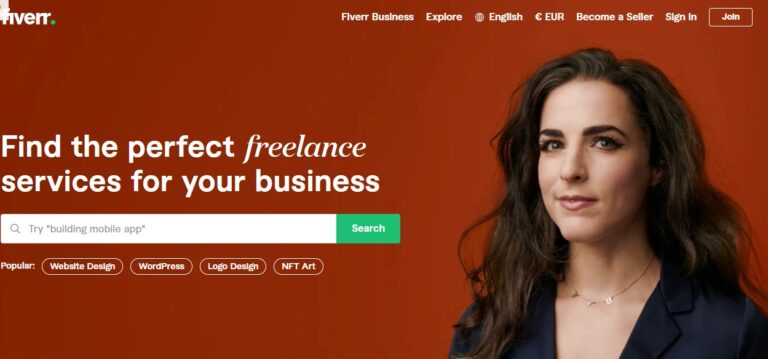Whether you are looking for a side gig or a new career, I made this step-by-step ultimate how to guide on freelancing. I will talk about what freelancers are and how they work. I will also cover the benefits of having a freelance career, and how to become a successful freelancer, market yourself and land freelancing jobs and new clients.
If you are tired of the daily 9 to 5, you are not alone. There is an increasing number of people jumping into freelancing, now more than ever. The pandemic put things in perspective, we value the quality of life more so than before.
What is freelancing? What is a freelancer?
Freelancing refers to the contracting of a freelance job by potential clients for a definite period.
A freelancer can work in a wide variety of disciplines and thus may be referred to with other titles such as an independent contractor or self-employed worker.
Freelancing involves completing contract tasks for many clients. Over half of the workforce is millennial, which makes them the fastest-growing demographic.
According to the latest economic trends, most employees will be working as freelancers by 2027.
Freelancers are independent workers who provide services to freelance clients without a formal employment agreement and are often hired by companies to complete specific projects or tasks.
They can be found in many different fields including marketing, design, and engineering.
They typically work from their homes or another location of their choice, which means they can set their own hours, choose which projects to take on, and be self-directed in their workflow.
A freelancing career can be great because it allows you to make your own schedule; however, it also requires smart tactics and good marketing skills to land those jobs.
You can lend a freelancing career as a graphic designer, web designer, web developer, marketing consulting, SEO, and many others, depending on your freelancing skills.

In order to get freelance clients, you should constantly work on improving your skillset through an online course, video tutorials free, or paid.
The pros and cons of freelancing
We need to take a closer eye at freelancing as a whole. No matter where you work, there will be benefits and disadvantages in your freelance career.
Benefits of being a Freelancer
The main reasons for freelancing include flexibility, freedom, and earning possibilities, while the biggest hurdle is income predictability, work opportunities, and rewards. It doesn’t matter what motivates you.
- You’re the Boss
This flexibility can be a big advantage if you’re a night person. You could work the whole night without ever leaving your house during it by sleeping in until noon, for example. Having your own business means you don’t have to work for anyone else, but only take on projects that are in line with your interests.
- You Can Make More Money
As the freelance model gains momentum, it’s important to keep in mind that freelancers can often earn more than someone working a 9-to-5 job. In fact, some reports have found they earn at least 45% more than the average full-time employee.
- Lower Taxes
The US federal and state taxes are not withheld from the wages of freelancers and as such, they need to file four tax returns per year and pay the IRS directly. Freelancers can also benefit from more deductions such as office, travel, meal, and education expenses.
- Work-Life Balance
29% of freelance workers work less than 40 hours per week, taking advantage of the fact that they have the freedom to choose their own working hours.
Studies have shown that freelance workers are healthier and psychologically well-adjusted in comparison to traditional employees. This is because they have greater control over their own workload, which can aid with stress, and have a better work-life balance.
Disadvantages of Freelancing
Freelancing is a great way to make money and work on your own terms. But it also comes with its share of challenges.
Freelancers often face challenges such as finding work, building a portfolio, and getting paid on time. However, there are ways you can manage to overcome these challenges and succeed in the freelance world.
This is a list of potential challenges that you might face as a freelancer and how to overcome those challenges:
- Being your own boss
You have to manage your time and work well with clients. This means being able to manage your time and be proactive about managing your clients’ expectations without micromanaging them.
When you’re freelancing, you’re in charge of every aspect of your business. You do all the decisions & work, including the bookkeeping, cash flow management and marketing. This can be advantageous because you are in full control of your work but it also means that there are more things to take care of.
- No steady income
As a freelancer, one of the most important things to think about when deciding when and how often to take a break is that when you’re not working, you’re losing income. So when you take a three-week vacation, be ready to spend it in a place where your skills or services are needed.
When you start out as a freelancer, you might experience months where there’s lots of work and the paychecks reflect that. However, sometimes you do less work during a month and your paycheck will be significantly lower than it was the previous month.
If you are struggling with finding work, consider branching out into new areas or adding tiered services. For example, if you offer to Copywrite, add writing blog posts, press releases, ghost book writing. Then learn basic SEO to complement the copy and add a more comprehensive service to a potential client.
- Lack of benefits, health insurance, etc.
Working for someone else will often mean they take care of your health or retirement plans; be it through health insurance, retirement benefits, bonuses like paid vacations, or profit-sharing. This is cheaper than buying your own health insurance plan which can often be expensive.
Freelancers don’t have employers to take care of taxes, benefits, etc. That’s why tools like this one exist for you so you can forego the hassle of managing your own records. And purchasing your own insurance can be more expensive than getting it through your employer, so more research is necessary.
- You Have to Handle Accounting
Taxes, bookkeeping, paying bills, and managing cash flow is your responsibility. Whilst there are tools available to help reduce the time spent on this task it’s still a chore that will require you to do it yourself with the help of guides, like this one, costing you more time.
- You Risk Not Getting Paid
Sometimes you’ll come across a client who doesn’t pay up at all or is slow in doing so. The risk is that many freelancers don’t know when work will be coming in and may struggle financially.
You must be able to motivate yourself – without prodding from an outside source. Though there are many pros and cons of freelancing, only you can decide if it’s right for you.
With freelancing, you never know where your next paycheck might come from. This uncertainty can make it tough to balance work and home life. For some people, having stability and predictability in their careers is extremely important.
Setting up Your Freelance Business
There are many ways to set up a freelance business. You can start a freelance business by yourself or you can join an online platform that will help you find clients and manage your work.
Find a Niche
The first step is to find a niche for your freelancing business. This niche should be something that you are passionate about and know a lot about.
This will make it easier for you to find clients and keep them coming back for more work from you.
The best way to find a niche is by doing some research on the internet or in person with people in the industry. Once you have found a niche, it is time to get started!
Depending on your qualifications and affinities, these are some of the industries and potential niches you could choose:
- Marketing – Project managers, Marketing coordinators, or Marketing managers
- Business Project Management – Project Manager, Process Analyst
- Web Development – Creating, testing, or providing support for software or apps
- Writing – Blog post, copy editors, and content managers
- Accounting
- Insurance Inspection – Gathering information, such as photographs, and writing insurance reports
- Teaching/Tutoring – Teaching online classes or being a tutor
- Social Media – Become a community manager or social media coordinator
- Graphic Design – Website and application designers
- Administrative Services – Professional virtual assistants
Setting up your business structure
As a freelancer, there are few options for creating a business entity. These are sole proprietorship, partnership, LLC, and corporation.
It is important to choose the correct structure because that will determine whether will be personally responsible for all liabilities of the freelancing business.
Sole Proprietor
A freelancer working as a sole proprietor is freelancing as a one-person business.
There are no legal distinctions between the freelancer and the freelancing business.
Under the sole proprietor business structure, you are viewed by your clients and customers as doing business under your own name.
Sole Proprietorship is the easiest and cheapest to set up. However, since you are freelancing under your own name (not a company), this limits what kind of liability protection you can get in case you get sued or involved in other legal issues.
Partnership
A partnership exists when two or more people share ownership and profits of an unincorporated business, and run it on a day-to-day basis.
Partnerships are not legal entities, so all the partners are liable for any liabilities of the business.
LLC (Limited Liability Company)
A freelancer may choose to form an LLC because it offers the limited liability protection of a corporation without many of the drawbacks.
Under the LLC business structure, freelancers work as independent contractors and still freelancing under their own name.
The freelancer is viewed as a separate entity (company) and does not necessarily need to use his/her actual name on official paper works and transactions with clients and customers.
LLC does not limit the liability protection freelancers who choose this business structure can get if he/she gets sued or involved in other legal issues.
One important thing to note is freelancers who freelance under the LLC business structure will be treated as employees by the IRS.
This means freelancers need to always pay taxes on freelancing income, no matter how much he/she earns in a year.
On the other hand, freelancers working under sole proprietor business structure are freelancing as independent contractors and freelancing income is not subject to taxes until freelancers reach $ x amount/year (this number changes almost every year).
Also, freelancers who freelance under the LLC business structure do not need to file a Schedule C.
Freelancers working under the sole proprietor business structure always need to complete this form and file it with the freelancer’s personal income tax.
Please keep in mind financial liability is not the only factor for freelancers to consider when setting up a business structure.
For example, there are taxes on freelancing income, working hours freelancers need to comply, etc.
Freelancers should always weigh all factors before deciding how to set up a freelancing business structure.
Note: freelancers working under sole proprietor business structure can always switch to LLC later on if they decide to do so. However, freelancers who freelance under LLC cannot go back to freelancing as sole proprietors.
This means freelancers should consider all factors carefully before deciding how to set up a freelancing business
I am not providing legal advice, just speaking from my own research, experience, and viewpoint. Do your consultation with a professional service for legal advice.
Setting Up Your Workplace
After taking some time to consider your options, you may have decided that being self-employed is the best decision for you.
With that in mind, it’s important to get your workplace sorted out before you start working.
If you live alone, you’re already ahead of the game. You can just sit at your kitchen table, or convert the spare bedroom into a workplace and stay focused without a distraction from others.
If you live with others, it is recommended that you find a space where you can be left alone during work hours. You’ll need a space to work in peace.
A lot of people want to be able to work from home – but if your house isn’t appropriate for this, consider working from a coffee shop or renting out office space.
When you’re working from home, it can be hard to focus on anything other than household chores and the commotion of the kids.
Professional coworking spaces will allow you to find peace and quiet in a shared office environment.
If your business is on a budget, there are many places to look-even the library has ample facilities for solitary work.
To find a location for your office, try to search for a place that’s not full of distractions and will suit your needs.
A writer only needs their laptop and an outlet nearby to work from. However, a photographer may need a darkroom to develop their photos.
Build Your Personal Brand
Establishing a personal brand is valuable for going freelance and creating a long-term relationship with clients.
Designing your own logo or using an online design program, like Canva, can go a long way towards that goal.
Along with developing a memorable logo, your personal brand should also include a business name.
You can choose to go with your own name or select a business name that is brandable.
If you use your name, your logo could be your initials in a unique font. You can place this on all of your website, social media accounts, and invoices.
It’s best practice to use your logo on all your online accounts to reinforce your branding.
Choosing your online platform
Your online presence is also an element of your personal brand and includes a website and social media accounts where you can share information about your notable projects, testimonials, and “market” your services.
It’s common practice to have a website for remote work where you can showcase your portfolio, share references, and promote.
Self-owned Website vs Hosted Website Platforms
My first choice is a self-hosted WordPress website.
Your own website is a platform you own, social media and Youtube and TikTok are platforms you can leverage, but you don’t own them.
Your account can be terminated at any time.
When choosing a domain for your website make sure it’s easy to remember, has few spelling errors, and articulates what you do.
For example, if your name is Nina Smith and you are a social media manager, maybe you would want to call the website www.ninasmith.com
Your website should also contain the following components:
- About me page that introduces yourself to prospective clients, such as education and qualifications, work experience, life journey, or whatever you think you should mention. Most importantly, it should speak to the user’s needs and how you will help them in achieving them.
- Explain the services that you offer.
- Example: My services are designed to help clients in the process of acquiring new customers by targeting niche groups with different marketing strategies.
- Show examples of your work.
- A portfolio is a perfect way for candidates to showcase their best work and demonstrate that they are an excellent fit for the job. A strong portfolio should showcase your skills and experience across a variety of different projects.
- Contact details like address, phone number, and email address.
- It is necessary to establish trust in your potential clients that you are a real person and/or business, and a professional.
Sites like Squarespace, WordPress, and Wix make it easier than ever to create an attractive, modern website.
They offer templates that let you display your work on your site, like writing samples or design portfolios.
Leverage Social Media
Keep your social media accounts updated. It’s good to maintain one account per social network or create a different account for your personal & professional brands.
Twitter: Follow the right people
Twitter offers a good means to establish contacts.
Follow someone or companies you’ve worked within the past and learn more about their businesses. It would be useful if someone wanted freelance work.
By commenting on their Twitter stories, we can reach them and let them know what we’ve been working on. You can follow other people from your field to develop partnerships and ultimately gain clients.
Twitter is fantastic for sharing news about your work and chatting with other professionals in the industry.
LinkedIn: Build business connections
Since LinkedIn is intended exclusively to connect people with jobs and businesses, it’s important to create a compelling profile and keep it updated.
The profile often appears at the top when a searcher searches for full-time or freelance talent from LinkedIn.
It helps to have a good first impression when a client looks at your resume.
LinkedIn allows users to post comments to keep their names top of mind. This tool can be used to look for connections with businesses that are looking for freelancers.
In October 2021 they added Freelancer Marketplace, a platform where freelancers can be found by potential employers for freelance gigs.
Facebook: Tell friends you’re freelancing
It may seem simple, but just putting your Facebook friends in touch will broaden your contacts and you may even get new clientele.
If you want more insight into your personal life, you can add a link to a compelling article.
There might be online communities where people from different industries share tips on the topic or your neighborhood might have a community forum where you can show off your expertise to the local businesses.
In addition, joining the Facebook alumni group can help you know where your classmates landed. Please watch out!
Instagram: Where a picture can be worth a thousand words
Instagram offers great opportunities to showcase the work that your work can do.
You can also use Instagram to promote your creativity that you rarely get to use at work to the maximum. Use the hashtag so that everyone can find your post.
Why is personal branding so important?
Traditionally, building a clean, consistent brand can communicate authority and professionalism to anyone viewing your work.
This will help establish you as an authority figure in your niche on the freelance market and make it easier to find paying clients.
Branding is a creative and powerful way to really acknowledge your personal values.
It enables you to come out from the pack by showcasing your professional attitude and gives you a chance to promote yourself effectively.
Creating a Portfolio
Your portfolio is a window to the quality of your work so it’s important for freelancers to have a large and impressive one.
This may seem time-consuming, but there are tools that can speed up the process.
Testimonials and copy can be great for marketing your services, but you need a portfolio because it helps people imagine how your work would benefit them.
Portfolios are great because they can weed out all the bad-fit clients that you don’t want to work with before they ever contact you.
Be sure to only include your best projects and focus on content that you’re proud of, showcase some diversity in skills & clients.
If you’re a writer, for example, provide examples of articles that discuss various topics in order to show how diverse your work is.
Include your contact information again so that it makes it easier for clients to get in touch with you.
The most common and convenient way to show your portfolio is by uploading various files of your work are Dropbox, Google Drive via links on your website or links posted on social media.
But there are third-party websites you can use as well.
These sites charge an amount for each project, but they do provide a much more public profile with greater search engine visibility for those looking to hire you.
- Contently — for writers, journalists, and content creators
- PortfolioBox — There’s a free version or Pro-edition of Portfolio so artists, designers, photographers, architects and more can have their own domain.
- CarbonMade — allows freelancers in a variety of fields to easily customize their portfolios with a personal domain (tailord towards illustrators, animators, architects, etc.)
- Behance — With a Creative Cloud account it’s a breeze to upload your work onto Behance. One of the most compelling features of Behance is the job board. This allows employers to find creatives to fill their vacancies. (for graphic designers, illustrators, UI/UX, etc.)
- Journo Portfolio —Excellent platform for journalists and writers
Setting Your Prices and Rates
Setting rates is probably the hardest part of freelancing. Whether it be hard to talk about money or decide on your rates, it’s essentially putting a dollar sign on your forehead. What are you worth?
Money can be a complicated subject to discuss-but with practice you can learn how to have these conversations.
One of the most important things is not getting too caught up in your own feelings about money. Instead of following a traditional pricing approach, consider an economic one instead.
As a business owner, you should consider how much time and effort go into your projects and let that be the deciding factor. You know you provide great work and chances are so does your client.
Here are a few tried-and-true strategies freelancers use to set their rates. In most cases, you can use a combination of the three categories that fit with your particular niche or specialty.
Cost-Plus Pricing
A popular way to figure out how much to charge is the cost-plus markup. You just figure out the cost of sourcing or producing your product, then add extra for profit, for example, 10-30% as profit.
This pricing model is best for artists & freelancers who use physical material and know the cost of completing a project or service.
For independent contractors, it can sometimes be hard to judge how much to charge with this method.
First, figure out your monthly expenses from rent, food, internet access, and health insurance. Then, estimate how much more you’ll need to cover your costs and make a profit.
It is very difficult to calculate what your business expenses will be for the year ahead.
For writers, designers, and developers, this model might be tough to calculate, unless you’re counting your time as the primary cost.
Market Rate Pricing
Market-rate pricing is where you make a decision about your prices based on what the market is currently charging for similar services.
The first step in calculating your price by market rates is to look at:
- Your industry,
- Your location and
- Other services in the same field and serve a similar audience.
While you may not have the experience to compete with freelancers with 10+ years of experience, you can still command a decent rate for your work.
Value-Based Pricing
Pricing based on your worth is another very popular approach. The work you produce can be tailored to suit specific clients, so costs will vary slightly depending on who the project is for.
This is why, for example, ads for Fortune 500 companies will often be more expensive than those for local coffee shops.
Now, the rates you determine for one company over the other depending on what they can afford and what impact they want. It can be difficult to compare without taking these things into account:
- How do you want to charge? For some freelancers it’s best to charge by the hour but some charge per project or per word for writers. What this also depends on is the kind of work you’re doing and what feels most comfortable for you. Hourly fees ensure you’re fully paid for the time you put in, whereas a fixed pricing puts more emphasis on the quality of work delivered. For most of the projects it makes sence to charge a fixd cost on a per project basis and estimating a time frame for the project to be delivered.
- You can decide whether or not you want to publish your prices on your website. Some freelancers make a decision to do this because it creates a perception of their value and weeds out clients who aren’t going to be the best fit. Other freelancers keep that info hidden in order to get clients on the phone. Keeping your prices private will allow you to change them when necessary.
How to Find Clients as a Freelancer?
Freelancing is a growing trend that gives people the freedom to work on their own terms. It is also a great way for people to build up their portfolios and get new skills.
However, freelancers need to find clients in order to make money.
There are many ways for freelancers to find clients, through their networks of friends and acquaintances, through job postings on digital marketplaces like Upwork or Guru, by browsing job boards like Indeed or Craigslist, and through referrals from other freelancers.
Here are some of the most effective ways:
– Create your own website where you can list your services and prices.
– Use social media platforms like LinkedIn, Facebook, or Twitter.
– Join freelance websites, where you can post your profile and connect with potential clients who are looking for specific skillsets.
Here are some common job sites on which you can establish a presence and check out some open gigs:
- CloudPeeps
- Fiverr
- LinkedIn Marketplace
- ProBlogger
- UpWork
- 99Designs
- SimplyHired
- Guru
How to Market Yourself as a Freelancer?
The key to success as a freelancer is marketing yourself well and making sure you have an online presence so potential clients can find you easily.
Freelance marketing is not just about promoting your services, but also about your brand image, your personal branding, and how you position yourself in front of potential clients.
With the rise of digital platforms and freelance marketplaces, it’s never been easier to start your own business and work on your own terms.
But, there’s a lot that goes into marketing yourself as a freelancer. You need to know what you’re worth, what people like about you, and what you can do for them, and then find ways to show that in your marketing materials.
Here Are 10 Tips to Help You Market Yourself as a Freelancer
But, there’s a lot that goes into marketing yourself as a freelancer.
You need to know what you’re worth, what people like about you, and what you can do for them, and then find ways to show that in your marketing materials.
Here are some tips to help you market yourself as a freelancer
- Have a clear understanding of who your target audience is and what they want from you.
- Be active on social media. Social media is a great place for freelancers because there are plenty of networking opportunities and it’s also a good way for you to showcase your work and make connections with other professionals in your field. It’s also a way to build your personal brand by investing time in building up an online presence on social media channels like TikTok, LinkedIn, Twitter, Facebook, etc.
- Maintain a professional appearance with all correspondence
- Be authentic. Be honest about your skillsets and experience
- Create a portfolio that showcases your work experience and skills to potential clients. A portfolio is your online resume and it’s important for any freelancer. It gives potential clients an idea of what you’re capable of doing, which makes it easier for them to decide whether they want to hire you. Upload it on your website.
- Network with other freelancers and join freelance communities. Network with others in your industry by attending events or online groups. For example, you might answer questions on Quora, engage with your LinkedIn or Facebook group relevant to your field.
- Ask for referrals and testimonials. You can get reviews from your personal & professional contacts. You’ve worked with them before so they can attest to your skills and reliability. You can also ask professors, past employers or mentors for a review. Copying their LinkedIn reviews to your website is an easy way to build up client trust.
- Create case studies that show your skills and experience, but also the results you got for your previous clients. Showcase them in your portfolio portfolio.
- Let your family & friends know about your freelance business so they can buy from you, and also tell people in your professional network since they might have clients who need this type of work done. The more people who know about your business, the more people they can refer you to.
- Offer freebies at the beginning to build up your portfolio faster. Offer free templates, free audits, free products, discounts whichever is applicable to your industry.
How to Approach Prospective Clients as a Freelancer?
The way you approach prospective clients determines the success of your business. You should approach them with a professional attitude and be confident about your skills.
You should also be able to demonstrate the value you can provide for their business.
It’s important to know the company’s needs and be able to offer a solution that will address their pain points.
One of the most important things you should do when approaching a prospective client is research.
The research will help you understand their needs and what they are looking for. It can also help you figure out the best way to approach them.
When you present your proposal, it is important that you show how you will help with implementing solutions and managing projects for them.
You should also be able to provide some evidence to back up your claim.
That is where your portfolio of work comes in. This will help you showcase your skillset, which will make you more appealing as a potential candidate for the client.
You need to make sure that you are professional and stay on top of your game.
Always follow up after a meeting or phone call with a thank you email, send a welcome package, or send a follow-up reminder about what was discussed during the meeting.
The Fundamentals of Creating an Effective Client Acquisition Strategy as a Freelance Consultant
There are many different ways to create an effective client acquisition strategy as a freelance marketer.
Some of the most common strategies are finding clients through networking, cold-calling, and even leveraging your personal network.
However, one of the best ways to find clients is through referrals.
This is because people are more likely to trust someone they know or have heard about before.
Referral marketing also allows you to build trust with your potential customers by showing them that you have been trusted by others in the past.
As a freelance consultant, you need to have an effective client acquisition strategy in order to grow your business.
Here are 5 tips for developing an effective client acquisition strategy:
- Create an irresistible offer – this will help you stand out from the competition and attract clients who are looking for your services.
- Be visible – create content that will help you reach potential clients so they can find you online.
- Network – attend networking events or trade shows where you can meet potential clients face
- Study up on your client’s industry
- What are the challenges facing the industry?
- Companies in the industry are constantly challenged with keeping up with the latest trends and technology. What is their main goal?
- Study the client’s company
- What are the challenges facing the company?
Why Should I Try Marketing Myself As A Freelancer?
The conclusion is that marketing oneself as a freelancer is not easy, but it is worth it.
There are plenty of benefits of being a freelancer, and you can have the freedom of working from home or traveling around the world if you want.
The only thing you need to do is invest time and effort into marketing yourself as a freelancer and presenting your work in an attractive way so that potential clients will hire you.
Freelancing is not about being an employee who gets paid by the hour or week.
It’s about getting paid based on the value you create for your clients, which is often more than what you would get as an employee of a company.
If you would like me to write about certain topics in more detail, let me know. I would like to add to the content with your input – what is of interest to you?







